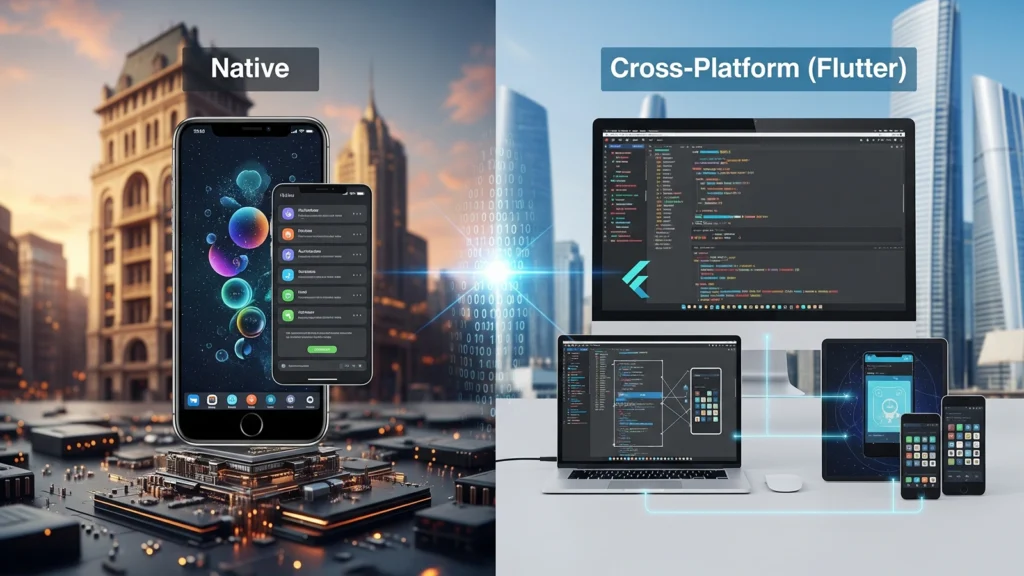
Imagine a company builds a powerful tool for streamlining its work. But the catch? It only runs on iOS. iPhone users are excited, but Android users are feeling left out. Now the company faces a dilemma. Should they build a whole new app for Android from scratch? But that means extra time, more developers, and higher costs!
This is where cross-platform mobile development comes in. This popular trend removed the need to maintain two separate apps. Now the developers can write one codebase and run it on both iOS and Android. It’s a smarter way to reach everyone without doubling the effort while saving time and resources. Wondering how it all works? You’re in the right place. In this article, we’ll learn what is cross-platform mobile development, why it’s important, and everything you need to know about it.
What is cross-platform mobile development?
Cross-platform mobile app development is a technical approach and a strategic solution for creating and deploying the same app for multiple operating systems. Developers can create the application from a single, unified codebase for both iOS and Android.
For example, let’s say you are developing a food-delivery app. If you are using the native development, then you’ll need to form two separate teams. One will be coding in Kotlin/Java for Android, and another in Swift/Objective-C for iOS. That means you are wasting both time and money. But if you go for cross-platform development and use frameworks like React Native or Flutter, then you’ll have an app that runs smoothly on both platforms.
And this is not just a theory. The movement began with the “hybrid era” with PhoneGap (now known as Apache Cordova) in 2011 and paved the way for today’s powerful cross-platform frameworks. Your favorite apps, like Instagram, Skype, Uber Eats, and Pinterest, run on cross-platform technology. This is how they are capturing millions of users worldwide while keeping development fast, consistent, and cost-effective.
How Does Cross-Platform Mobile Development Work?

As we said before, cross-platform development means writing the code once and then running it on multiple platforms like iOS and Android. Here’s how it works:
- Developers write the app code in one common programming language like JavaScript, Dart, or C#.
- Frameworks (React Native, Flutter, or Xamarin) act like a bridge and convert that single code into versions that both iOS and Android devices can understand.
- Then the frameworks use native UI elements (buttons, menus, navigation bars) so that users may feel they’re using a real iOS or Android app.
- The framework provides plugins/APIs to access features like camera, GPS, push notifications, or storage if needed. No separate code for each platform is needed.
- After that, the app is compiled. The same code is turned into an APK for Android and an IPA for iOS. Then they are ready to upload to the Google Play Store or the Apple App Store.
The Need for Cross-Platform Mobile Development
Nowadays, we rely on mobile apps more than we use our desktops. According to 42matters, both Android and iOS dominate the global mobile operating system market by hosting 2,071,065 apps on the Google Play Store and 1,999,434 apps on the Apple App Store. This means ignoring either platform can leave out half the users.
Historically, developers often had to create separate native apps for each platform because code for one OS couldn’t be reused on another. This was not only time-consuming but also expensive. Cross-platform mobile development solves this problem. Updates and new features can be rolled out consistently without doubling the effort. Startups can launch faster, test their ideas, and iterate quickly. Enterprises can maintain a single codebase and deliver a uniform user experience across devices. In today’s digital world, learning about cross-platform development and utilizing it is no longer just convenient but a necessity.
Native vs. Cross-Platform Development

Businesses have two main options when building an app: native development or cross-platform development. Native mobile development has a strong fan base because of its stronger performance. However, cross-platform development has fewer chances of security errors and is faster to market. So, which one should a company go for? Here’s a comparison table to help them choose.
| Feature | Native Development | Cross-Platform Development |
| Codebase | Separate for each platform | Single shared codebase |
| Development Languages | iOS: Swift, Objective-CAndroid: Java, Kotlin | JavaScript (React Native), Dart (Flutter), C# (Xamarin), HTML/CSS/JS (Ionic) |
| Performance | High and optimal | Slightly lower in graphically-intensive apps |
| Access to Native Features | Full access | Mostly full, but sometimes limited or needs plugins |
| Cost | Higher due to a separate team and more time | Lower development cost |
| Updates & Maintenance | Separate updates per platform | Updating once can work for all platforms |
| User Experience (UX) | Fully native, follows each platform’s design guidelines exactly. | Can look and feel very similar to native apps, but some subtle differences may appear. |
So if a company is developing games or heavy graphics apps and wants deep integration with device hardware, then native development would be the best choice. But if they want Social apps, content apps, or e-commerce apps with easier updates, then cross-platform development is the way to go.
What are the Benefits of a Cross-Platform Mobile Development?
Cross-platform mobile development has grown significantly and has tremendous benefits for businesses and developers. Some of the benefits are written below:
- It’s very cost-effective. Companies can save money on design, testing, and maintenance.
- Faster development for the shared codebase. Businesses can market the app quickly than native development.
- Reusable code components across different platforms enhance productivity.
- Easy to fix a bug or add a new feature.
- Wider audience reach with the same effort.
- UX is consistent across all devices. This is crucial for building a strong and recognizable brand identity.
Disadvantages of Cross-Platform Mobile Application Development
Every coin has two sides. There are a few disadvantageous of cross-platform mobile app development. Some of them are;
- Cross-platform apps may work a little slower for resource-intensive applications like complex games or 3D animations. This is because cross-platform frameworks often use a “bridge” or an abstraction layer to translate the code into native components.
- Limited access to native features.
- Larger file size compared to their native counterpart.
- Higher dependency on the framework.
What Popular Frameworks Are Used in Cross-Platform App Development?
The popular frameworks used in cross-platform app development include:
- React Native
Created By: Meta/Facebook in 2015
Language: based on React JavaScript library and enhanced with TypeScript for type safety. Also supports multiple languages like Java, Swift, and C.
Main Features:
- Hot reloading
- flexible UI components
- New Architecture (Fabric, TurboModules, JSI)
- Declarative UI
- Plugin & native-module support (camera, sensors, etc.)
- Strong community support, etc.
Pros:
- It can give a native-like experience.
- Reusable codes.
- It translates the source code into native components to enhance UX.
- Very easy to use.
Examples of Apps: Instagram, Facebook, Shopify, Discord, etc.
- Flutter
Created By: Google in 2017
Language: Dart (Google’s UI-focused programming language)
Main Features:
- Widget-based architecture
- Single codebase for iOS, Android, web, and desktop
- Material Design & Cupertino widgets for platform-specific look and feel
- High-performance rendering engine (Skia)
Pros:
- It has hot reload, so super-fast development cycles.
- Truly native-like performance
- Excellent performance and smooth animations.
Examples of Apps: Google Ads, Google Play, Alibaba, BMW, Reflectly
- Xamarin
Created By: Xamarin in 2011, it was later acquired by Microsoft in 2016. Evolved into .NET MAUI (Multi-platform App UI) in 2022.
Language: C# and the .NET Framework.
Main Features:
- Access to native APIs and libraries through .NET bindings
- Strong integration with the Microsoft ecosystem (Visual Studio, Azure)
- Shared codebase for business logic
- MVVM (Model-View-ViewModel) support
Pros:
- Near-native performance.
- Mature ecosystem
Examples of Apps: Alaska Airlines, Microsoft News, Storyo, The World Bank
- Ionic
Created By: Drifty Co. (now Ionic) in 2013
Language: HTML, CSS, JavaScript, with support for Angular, React, and Vue
Main Features:
- Hybrid app development
- Web-based technology stack
- Capacitor & Cordova plugins for accessing native device features
Pros:
- Cost-effective.
- Easy to maintain a single codebase.
- Suitable for building Progressive Web Apps (PWAs).
Examples of Apps: Sworkit, MarketWatch, Diesel, JustWatch
- Kotlin Multiplatform Mobile (KMM)
Created By: JetBrains in 2020
Language: Kotlin
Main Features:
- Share business logic (data, networking, core features) across Android and iOS
- Full interoperability with existing Java (Android) and Swift/Objective-C (iOS) code
- Strong support in IntelliJ IDEA and Android Studio
Pros:
- Allows sharing of non-UI code between iOS and Android.
- Native user experience.
- Strong tooling from JetBrains and Google support
Examples of Apps: Trikot, Cash App, Netflix
Future Trends in Cross-Platform Development
Cross-platform mobile development has already evolved from being a niche alternative to a mainstream solution for building apps. One big trend would be Flutter expanding beyond mobile to web and desktop. This will help developers reach more devices with the same code.
Kotlin Multiplatform is also becoming more popular. Moreover, frameworks like Flutter and React Native are increasingly using “Declarative UI” to simplify the process further.
Finally, AI-powered tools are starting to assist developers by speeding up coding, testing, and design.
Conclusion
Cross-platform mobile development is a strategic choice for businesses and developers alike. This approach provides a highly efficient and budget-friendly solution for a majority of applications. The future of this field is even more promising. So if you want to capture your audience quickly, save time, and provide a scalable app for today’s mobile-first world, then consider a cross-platform approach. Weigh the pros and cons, which framework works best for you, and if it fits your goal. We hope this guide helps you deploy your next big idea!
FAQs
- How much does it cost to develop a cross-platform mobile app?
The average cost depends on complexity, features, and target platforms. But developing cross-platform mobile apps is budget-friendly and is generally 30-50% more cost-effective than building a native app.
- What Programming Languages are used in Cross-Platform App Development?
Programming languages like JavaScript, Dart, C++, Python, Rust, Kotlin, Typescript, and C# are used in Cross-Platform App Development.
- Are cross-platform apps slower than native apps?
This is a misconception. Yes, it’s true that early cross-platform apps were often slower, but the modern frameworks have significantly improved performance.
